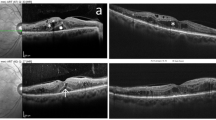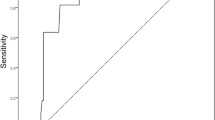Abstract
Background
To compare the anatomic and functional results between optical coherence tomography (OCT)-guided selective focal laser photocoagulation (OCT–laser) and conventional modified Early Treatment Diabetic Retinopathy Study (mETDRS) laser treatment for diabetic macular edema (DME).
Methods
We analyzed treatment outcomes in 47 consecutive eyes treated with OCT–laser compared to 31 matched eyes treated with mETDRS. In the OCT–laser group, we identified ‘significant actively-leaking microaneurysms on OCT’ (SALMO) which are responsible for edema in OCT B-scan images, and thoroughly ablated them with photocoagulation. Best-corrected visual acuity (BCVA) and retinal thickness by OCT were compared at baseline and 12 months after treatment between two groups.
Results
OCT–laser treatment resulted in significant improvements in BCVA, central subfield thickness (CST), and maximum retinal thickness (MRT) from baseline at 12 months from the time of therapy (+2.5 letter score, p = 0.04; −45.56 μm in CST, p < 0.001; −91.6 μm in MRT, p < 0.001). The mean number of treated ‘SALMO’ was 5.6 ± 4.0 (range 1–26), while the number of MAs in ‘treatable lesions’ by fluorescein angiography (FA) in the same eye was 16.3 ± 11.8 (range 2–42). There was no difference between OCT–laser and mETDRS groups in changes of these parameters from baseline at 12 months (p = 0.56, p = 0.89, p = 0.43 respectively). Fundus autofluorescence (FAF) and OCT revealed less tissue damage in OCT–laser-treated eyes, compared to eyes treated with mETDRS (p < 0.001).
Conclusions
OCT–laser shows similar anatomic and functional outcomes compared to conventional laser (modified ETDRS), with significantly less retinal damages.




Similar content being viewed by others
References
Early Treatment Diabetic Retinopathy Study Research Group (1985) Photocoagulation for diabetic macular edema. Early Treatment Diabetic Retinopathy Study Report Number 1. Arch Ophthalmol 103:1796–1806
Aiello LP, Edwards AR, Beck RW et al (2010) Factors associated with improvement and worsening of visual acuity 2 years after focal/grid photocoagulation for diabetic macular edema. Ophthalmology 117:946–953
Diabetic Retinopathy Clinical Research Network, Elman MJ, Aiello LP et al (2010) Randomized trial evaluating ranibizumab plus prompt or deferred laser or triamcinolone plus prompt laser for diabetic macular edema. Ophthalmology 117:1064–1077
Blair NP, Shahidi M, Lai WW, Zelkha R (2008) Correlation between microaneurysms and retinal thickness in diabetic macular edema. Retina 28:1097–1103
Writing Committee for the Diabetic Retinopathy Clinical Research Network, Fong DS, Strauber SF et al (2007) Comparison of the modified Early Treatment Diabetic Retinopathy Study and mild macular grid laser photocoagulation strategies for diabetic macular edema. Arch Ophthalmol 125:469–480
Van Dijk HW, Verbraak FD, Kok PHB et al (2013) Variability in photocoagulation treatment of diabetic macular oedema. Acta Ophthalmol 91(8):722–727
Massin P, Bandello F, Garweg JG et al (2010) Safety and efficacy of ranibizumab in diabetic macular edema (RESOLVE Study): a 12-month, randomized, controlled, double-masked, multicenter phase II study. Diabetes Care 33:2399–2405
Nguyen QD, Brown DM, Marcus DM et al (2012) Ranibizumab for diabetic macular edema: results from 2 phase III randomized trials: RISE and RIDE. Ophthalmology 119:789–801
Mitchell P, Bandello F, Schmidt-Erfurth U et al (2011) The RESTORE study: ranibizumab monotherapy or combined with laser versus laser monotherapy for diabetic macular edema. Ophthalmology 118:615–625
Do DV, Nguyen QD, Khwaja AA et al (2013) Ranibizumab for edema of the macula in diabetes study: 3-year outcomes and the need for prolonged frequent treatment. JAMA Ophthalmol 131:139–145
Wang H, Chhablani J, Freeman WR et al (2012) Characterization of diabetic microaneurysms by simultaneous fluorescein angiography and spectral-domain optical coherence tomography. Am J Ophthalmol 153:861–867
Horii T, Murakami T, Nishijima K et al (2010) Optical coherence tomographic characteristics of microaneurysms in diabetic retinopathy. Am J Ophthalmol 150:840–848
Byeon SH, Chu YK, Hong YT et al (2012) New insights into the pathoanatomy of diabetic macular edema: angiographic patterns and optical coherence tomography. Retina 32:1087–1099
Early Treatment Diabetic Retinopathy Study Research Group (1987) Treatment techniques and clinical guidelines for photocoagulation of diabetic macular edema. Early Treatment Diabetic Retinopathy Study Report Number 2. Ophthalmology 94:761–774
Shahidi M, Ogura Y, Blair NP et al (1991) Retinal thickness analysis for quantitative assessment of diabetic macular edema. Arch Ophthalmol 109:1115–1119
Lobo CL, Bernardes RC, Cunha-Vaz JG (2000) Alterations of the blood-retinal barrier and retinal thickness in preclinical retinopathy in subjects with type 2 diabetes. Arch Ophthalmol 118:1364–1369
Early Treatment Diabetic Retinopathy Study Research Group (1995) Focal photocoagulation treatment of diabetic macular edema. Relationship of treatment effect to fluorescein angiographic and other retinal characteristics at baseline: ETDRS report no. 19. Arch Ophthalmol 113:1144–1155
Lee SN, Chhablani J, Chan CK et al (2013) Characterization of microaneurysm closure after focal laser photocoagulation in diabetic macular edema. Am J Ophthalmol 155:905–912
Tso MO (1982) Pathology of cystoid macular edema. Ophthalmology 89:902–915
Wolter JR (1981) The histopathology of cystoid macular edema. Graefes Arch Clin Exp Ophthalmol 216:85–101
Snodderly DM, Weinhaus RS (1990) Retinal vasculature of the fovea of the squirrel monkey, Saimiri sciureus: three-dimensional architecture, visual screening, and relationships to the neuronal layers. J Comp Neurol 297:145–163
Kozak I, Oster SF, Cortes MA et al (2011) Clinical evaluation and treatment accuracy in diabetic macular edema using navigated laser photocoagulator NAVILAS. Ophthalmology 118:1119–1124
Maeshima K, Utsugi-Sutoh N, Otani T, Kishi S (2004) Progressive enlargement of scattered photocoagulation scars in diabetic retinopathy. Retina 24:507–511
Han DP, Mieler WF, Burton TC (1992) Submacular fibrosis after photocoagulation for diabetic macular edema. Am J Ophthalmol 113:513–521
Nguyen QD, Shah SM, Khwaja AA et al (2010) Two-year outcomes of the ranibizumab for edema of the mAcula in diabetes (READ-2) study. Ophthalmology 117:2146–2151
Acknowledgments
This research was supported by Basic Science Research Program through the National Research Foundation of Korea (NRF) funded by the Ministry of Education (2013R1A1A2007865)
Meeting Presentation: Partly presented at the 36th annual meeting of the Macular Society, Feb 2013, Dana Point, CA, USA.
The authors want to thank Hye Sun Lee (Biostatistics Collaboration Unit, Yonsei University College of Medicine) for statistical support.
Conflict of interest
The authors have no proprietary or commercial interest in any materials discussed in this article.
Author information
Authors and Affiliations
Corresponding author
Electronic supplementary material
Below is the link to the electronic supplementary material.
Serial morphological changes on OCT after OCT-guided selective focal laser photocoagulation. Serial regression pattern of ‘significant actively leaking microaneurysms on OCT’ (SALMO) with resolution of adjacent edema after OCT-guided selective focal laser photocoagulation (MPG 4448 kb)
Rights and permissions
About this article
Cite this article
Shin, J.Y., Byeon, S.H. & Kwon, O.W. Optical coherence tomography-guided selective focal laser photocoagulation: a novel laser protocol for diabetic macular edema. Graefes Arch Clin Exp Ophthalmol 253, 527–535 (2015). https://doi.org/10.1007/s00417-014-2729-9
Received:
Revised:
Accepted:
Published:
Issue Date:
DOI: https://doi.org/10.1007/s00417-014-2729-9




